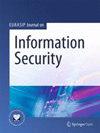颤抖触发器:探索基于dnn的人脸识别后门的敏感性
IF 2.5
Q2 COMPUTER SCIENCE, INFORMATION SYSTEMS
引用次数: 9
摘要
针对监督机器学习方法的后门攻击试图以这样一种方式修改训练样本,即在推理时,输入数据中特定模式(触发器)的存在导致对手选择的目标类的错误分类。针对基于深度神经网络(dnn)的人脸识别系统,已经出现了成功的后门攻击。这些攻击在训练和推理时被评估为相同的触发。然而,在实践中,后门攻击的脆弱性关键取决于后门分类器对近似触发输入的敏感性。为了评估这一点,我们研究了用于人脸识别的后门深度神经网络对触发信号的响应,这些信号已被不同强度的典型图像处理算子转换。不同类型的几何和颜色变换的结果表明,特别是几何错位和触发器的部分遮挡限制了后门攻击所考虑的有效性。此外,我们的分析表明,触发器与受试者面部的空间相互作用会影响攻击的成功。在实时采集中插入物理触发器的实验验证了数字插入触发器时观察到的DNN响应。本文章由计算机程序翻译,如有差异,请以英文原文为准。
Trembling triggers: exploring the sensitivity of backdoors in DNN-based face recognition
Backdoor attacks against supervised machine learning methods seek to modify the training samples in such a way that, at inference time, the presence of a specific pattern (trigger) in the input data causes misclassifications to a target class chosen by the adversary. Successful backdoor attacks have been presented in particular for face recognition systems based on deep neural networks (DNNs). These attacks were evaluated for identical triggers at training and inference time. However, the vulnerability to backdoor attacks in practice crucially depends on the sensitivity of the backdoored classifier to approximate trigger inputs. To assess this, we study the response of a backdoored DNN for face recognition to trigger signals that have been transformed with typical image processing operators of varying strength. Results for different kinds of geometric and color transformations suggest that in particular geometric misplacements and partial occlusions of the trigger limit the effectiveness of the backdoor attacks considered. Moreover, our analysis reveals that the spatial interaction of the trigger with the subject’s face affects the success of the attack. Experiments with physical triggers inserted in live acquisitions validate the observed response of the DNN when triggers are inserted digitally.
求助全文
通过发布文献求助,成功后即可免费获取论文全文。
去求助
来源期刊

EURASIP Journal on Information Security
COMPUTER SCIENCE, INFORMATION SYSTEMS-
CiteScore
8.80
自引率
0.00%
发文量
6
审稿时长
13 weeks
期刊介绍:
The overall goal of the EURASIP Journal on Information Security, sponsored by the European Association for Signal Processing (EURASIP), is to bring together researchers and practitioners dealing with the general field of information security, with a particular emphasis on the use of signal processing tools in adversarial environments. As such, it addresses all works whereby security is achieved through a combination of techniques from cryptography, computer security, machine learning and multimedia signal processing. Application domains lie, for example, in secure storage, retrieval and tracking of multimedia data, secure outsourcing of computations, forgery detection of multimedia data, or secure use of biometrics. The journal also welcomes survey papers that give the reader a gentle introduction to one of the topics covered as well as papers that report large-scale experimental evaluations of existing techniques. Pure cryptographic papers are outside the scope of the journal. Topics relevant to the journal include, but are not limited to: • Multimedia security primitives (such digital watermarking, perceptual hashing, multimedia authentictaion) • Steganography and Steganalysis • Fingerprinting and traitor tracing • Joint signal processing and encryption, signal processing in the encrypted domain, applied cryptography • Biometrics (fusion, multimodal biometrics, protocols, security issues) • Digital forensics • Multimedia signal processing approaches tailored towards adversarial environments • Machine learning in adversarial environments • Digital Rights Management • Network security (such as physical layer security, intrusion detection) • Hardware security, Physical Unclonable Functions • Privacy-Enhancing Technologies for multimedia data • Private data analysis, security in outsourced computations, cloud privacy
 求助内容:
求助内容: 应助结果提醒方式:
应助结果提醒方式:


